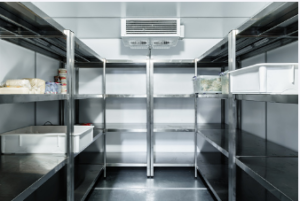Industrial refrigeration is essential in protecting products that would spoil or be compromised without it, and many manufacturing processes where chemical degradation must be prevented.
 Add heat recovery to a basic refrigeration system is possible in new and existing installations but will require additional equipment and planning to reap significant energy cost savings.
Add heat recovery to a basic refrigeration system is possible in new and existing installations but will require additional equipment and planning to reap significant energy cost savings.
Refrigeration
Industrial refrigeration Adelaide cost processes are essential in industries like food & beverages, pharmaceuticals and chemicals that must adhere to certain temperature operating standards, necessitating large refrigeration plants that ensure ideal cooling conditions.
Dairies require chilled process water to produce cheese, which keeps milk fresher for consumption, prevents equipment from spoiling, and helps lower energy costs overall. Breweries, wineries, and bakeries must use chilled process water similarly.
Industry refrigeration also plays a critical role in transporting temperature-sensitive goods like food or medicines. Companies utilising industrial refrigeration must have efficient warehouses and transportation systems that maintain an uninterrupted cold chain.
Refrigeration has many applications that extend beyond cooling systems, particularly industries that produce significant heat while working, such as electricity generation. Turbine Inlet Air Cooling Systems such as those offered by ARANER can assist by reducing the temperature of hot air streams emerging from turbines, thus improving electrical production efficiency and lowering maintenance operations costs. Refrigeration systems for air conditioning in commercial buildings and data centres also rely on this technology, making refrigeration an integral part of modern life as it allows cities to be built on hills or mountains that would otherwise be inaccessible due to natural barriers like rivers or valleys trails.
Cooling
Industrial refrigeration encompasses all the equipment and accessories used to remove heat from large-scale processes and materials and lower them to desired values. As such, its applications go far beyond simple air conditioning systems in scope and detail.
Mechanical contractors skilled in installing, servicing, and maintaining Industrial refrigeration Adelaide cost will find many opportunities across various sectors. A key market for such solutions is food processing; dairies, breweries and wineries require chilled process water to avoid bacteria growth, which requires chilled process water, while cheese production also necessitates cooling solutions.
Chemical and petrochemical industries also benefit from industrial refrigeration systems. Distillations, crystallisations, and condensation processes all require heat removal from their processes, which requires industrial refrigeration systems for proper functioning.
Logistics, catering clean rooms, and ice sports such as hockey and skating also utilise industrial refrigeration, while it can also help freeze materials such as sand and cement before excavation can occur safely.
Refrigeration industries rapidly adopt technologies like AI and ML to monitor performance, predict maintenance issues and optimise energy consumption. This trend also assists with transitioning from high global warming potential (GWP) working fluids such as ammonia or carbon dioxide to lower GWP refrigerants like ammonia or propane – with constant monitoring and automated responses helping industrial refrigeration become more cost-efficient while still offering food safety to end consumers.
Heat Recovery
Industrial refrigeration systems consume high amounts of electricity to function, prompting concerns from consumers and environmental protection agencies. In particular, supermarkets, ice rinks and warehouse food storage facilities use considerable power when cooling food storage products and processes. Carnot Refrigeration’s new energy recovery system repurposes heat from exhaust gasses in cooling processes reducing overall energy use while saving costs associated with electricity bills.
Ammonia
Ammonia (NH3) has long been used as an energy-efficient refrigerant, making it one of the longest-standing refrigerants on the market. Used extensively in commercial and industrial refrigeration applications, its long history of safe use makes it one of the top choices among refrigerants available today. Furthermore, unlike fluorinated refrigerants, it doesn’t deplete ozone layers; moreover, it ranks as one of the more cost-effective choices available to manufacturers.
Fritz Haber and Carl Bosch developed a process for producing ammonia through catalytic conversion of nitrogen and hydrogen at high temperatures and pressure, producing liquid ammonia as a coolant often used in industrial settings and acting as a building block chemical and stabiliser.
Ammonia absorbs heat from its surroundings and is drawn back into the compressor for another cycle. Depending on your system design, ammonia could be compressed in either single or two stages to reach low temperatures.
